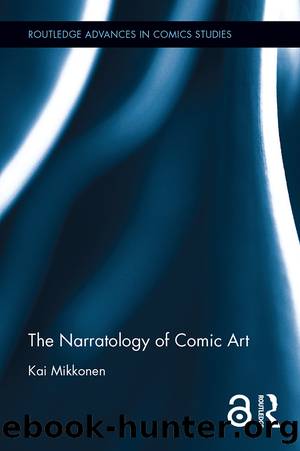The Narratology of Comic Art by Kai Mikkonen

Author:Kai Mikkonen [Mikkonen, Kai]
Language: eng
Format: epub
Tags: Social Science, Media Studies, Literary Criticism, Comics & Graphic Novels, General
ISBN: 9781315410111
Google: GafODgAAQBAJ
Publisher: Routledge
Published: 2017-05-08T04:31:51+00:00
Who Speaks? Who Sees? and What Is Shown?
Recently, there has been a strong trend in so-called postclassical narratology to emphasise perception as a fundamental cognitive frame in understanding any narrative, while these new theories have again challenged earlier definitions, typologies, and uses of the focalisation concept. Perhaps most importantly, Monika Fludernik has called our attention to the idea that focalisation is largely an interpretive category, or at least ânot exclusively a textual categoryâ (1996, 345), i.e. a postulation that is determined by the processing of certain textual clues, which in literature are verbal clues, such as deictic and expressive markers. The person who âseesâ, as she claims, âis the reader, but à travers the linguistic medium, and not in terms of visual perceptionâ (Fludernik 1996, 345). For this reason, Fludernik argues that narratology has assigned false rigour to the distinction between âwho speaksâ and âwho seesâ. Furthermore, Fludernikâs subordination of perceptional parameters in a narrativeâor the perceptual metaphorâto the question of the presentation of consciousness may help us to see how it does not always matter who speaks or sees in the narrative (1996, 345â346). What may be much more important is how the reader, or the viewer, gets optimal information about a characterâs consciousness: his or her motivations, thoughts, and perceptions.
In the multimodal narrative environment of comics, the classical narratological distinction into voice and mode (or focalisation) must be modified for at least three reasons. First, the question of Who sees? or Where is the focus of perception? is relevant on two different modal levels simultaneously, both in words and in images. Focalisation is expressed in words in Taniguchiâs A Distant Neighbourhood, for instance, when the narrator relates his emotions and thoughts as he looks at his little sister who is sleeping next to him (âI notice the light breathing of my sister sleeping beside me. It feels very strangeâ; âI canât believe that Iâm sitting here like thisâ¦looking at my elementary school-aged little sisterâ, 63). At the same time, focalisation is realised visually in a series of perspectival shifts between the narratorâs gaze images and the object of looking at different angles.
Second, while the question of Who speaks? is significant in relation to verbal narration in comics, that relationship must also be reconciled with the visual narration and information. In the multimodal context, the formal markers of perspectival filtering, therefore, are necessarily both verbal (metaphorical) and visual (literal) clues that require the reader to integrate perceptual information from different semiotic channels in a meaningful way, for instance, in terms of complementary functions or contrast. Thus, the question of cross-referencing, or interplay, between visual and verbal information conditions the distinction between focalisation and narration. Wordless comics make an important exception in this case, as the question of Who speaks? can become largely irrelevant, even if, insofar as a wordless comic has a title, the issue of how to relate images to words remains pertinent.
Third, as comics can also narrate without any words, we need to add to the questions
Download
This site does not store any files on its server. We only index and link to content provided by other sites. Please contact the content providers to delete copyright contents if any and email us, we'll remove relevant links or contents immediately.
4 3 2 1: A Novel by Paul Auster(12181)
The handmaid's tale by Margaret Atwood(7626)
Giovanni's Room by James Baldwin(7096)
Asking the Right Questions: A Guide to Critical Thinking by M. Neil Browne & Stuart M. Keeley(5565)
Big Magic: Creative Living Beyond Fear by Elizabeth Gilbert(5541)
Ego Is the Enemy by Ryan Holiday(5211)
The Body: A Guide for Occupants by Bill Bryson(4859)
On Writing A Memoir of the Craft by Stephen King(4809)
Ken Follett - World without end by Ken Follett(4581)
Adulting by Kelly Williams Brown(4425)
Bluets by Maggie Nelson(4420)
Eat That Frog! by Brian Tracy(4357)
Guilty Pleasures by Laurell K Hamilton(4257)
The Poetry of Pablo Neruda by Pablo Neruda(3969)
Alive: The Story of the Andes Survivors by Piers Paul Read(3905)
White Noise - A Novel by Don DeLillo(3905)
Fingerprints of the Gods by Graham Hancock(3872)
The Book of Joy by Dalai Lama(3840)
The Bookshop by Penelope Fitzgerald(3707)
